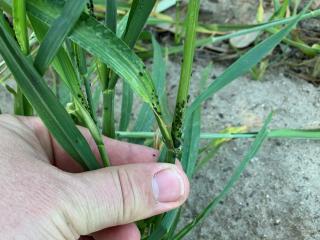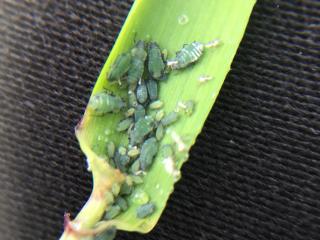Cereal aphid species need to be correctly identified
- Merredin
- Nunile
- York
- Highbury
- Katanning
Research scientist Grace Williams (DPIRD) has recently found corn aphids in booting La Trobe barley near Merredin.
Entomologist Dustin Severtson (DPIRD) has recently reported finding low levels of oat aphids in a wheat crop near Nunile.
Cara Allan (Syngenta) has also recently found corn and oat aphids in a barley trial near York. The plants were the booting growth stage.
Research scientist Kylie Chambers (DPIRD) reports finding oat aphids recently in Highbury and Katanning oat crops.
Identifying cereal aphids
It is important that growers, consultants and agronomists correctly distinguish between cereal aphid species for effective aphid management.
The Russian wheat aphid was recently detected north of Esperance. For more information on this exotic pest refer the 2020 PestFax Issue Russian wheat aphid found in Esperance region.
Growers, consultants and agronomists are encouraged to request aphid identification or report any suspect detections of RWA or RWA damage to the DPIRD Pest and Disease Information Service on +61 (0)8 9368 3080. Alternatively you can report by using the MyPestGuide™ Reporter app, PestFax Reporter app or MyPestGuide™ Reporter web page.
Reporting the absence of RWA or RWA symptoms is just as important as reporting the presence of the aphid or symptoms.
Managing cereal aphids
In most cereal growing areas aphids may be found on parts of the crop but they usually remain at low numbers without the need for chemical intervention.
Regular monitoring of cereal crops to determine changes in aphid populations and waiting until close to threshold levels of aphids before spraying is the recommended practice. Crop inspections at several locations around cereal paddocks is recommended as aphid density will vary within crops. Look on the stems, undersides of leaves and in the furled growing tips for clusters of aphid colonies.
Direct feeding damage from aphids occurs when colonies of aphids develop on stems, leaves and heads, usually in the tillering and later stages of crop growth through to head filling. The degree of damage depends particularly on the percentage of tillers infested, the number of aphids per tiller and the duration of the infestation. If low numbers of aphids are observed, wait until threshold levels are reached before considering control options.
Barley crops are most at risk from aphids due to the possibility of downgrading from malt to feed quality, as aphid feeding damage can cause grain shrivelling. If 50 per cent of tillers have 15 or more aphids then the feeding damage may cause reductions in yields by up to 10 per cent and also reduce grain size.
Keep in mind that naturally occurring parasitoids and predators such as wasps, lacewings and ladybird beetles will also increase with warming weather. These predators can keep aphid populations below threshold levels and un-necessary spraying of “anti-feed” synthetic pyrethroid sprays will only counteract their benefits.
When spraying, consider spray options that are soft on predators.
Also dense aphid colonies are prone to fungal pathogens. Aphids infected by fungi are sluggish and have white to yellow ‘fur’ covering their bodies. The fungus can readily spread throughout aphid colonies. The fungus especially is more effective in decreasing aphid populations than chemical control.
For a list of insecticides registered for use on aphids see DPIRD’s 2020 Winter Spring Insecticide Guide.
For more information on cereal aphids refer to DPIRD’s;
- 2020 PestFax Issue 9 Cereal aphids article
- Diagnosing cereal aphids page
- 2017 Protecting WA Crops Issue 3 newsletter Aphids – WA’s insect problem children.
For more information on aphids contact Svetlana Micic, Research scientist, Albany on +61 (0)8 9892 8591 or Alan Lord, Technical officer, South Perth on +61 (0)8 9368 3758.
Article authors: Cindy Webster (DPIRD Narrogin) and Svetlana Micic (DPIRD Albany).
Article input: Alan Lord (DPIRD South Perth) and Bill Trend (DPIRD South Perth).



